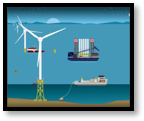
Factsheet 1 - Secondary Steel
Secondary steel refers to elements that fit on the main (primary) structural elements. These elements enable functions such as access to the turbine and protection for ancillary components. Secondary steel includes a wide range of subcomponents, from small scale items such as brackets and doors to large structures such as I and J Tubes, boat landings and work platforms weighing up to 50 tonnes.







